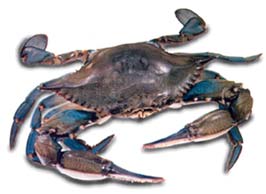



| Blue Crabs | Oysters | Cynthia Cudaback |

The population of eastern oysters in Pamlico Sound, and on most of the Eastern and Gulf Coasts, is threatened by overfishing, habitat loss and disease. Not oyster are oysters important to the economy, but they also filter a tremendous amount of water (6 liters/hour/oyster) and provide essential reef habitat. Governments, scientists and citizens are all working together to help restore the oyster population.
The North Carolina Division of Marine Fisheries is building oyster reefs in Pamlico Sound, to be used as spawning sanctuaries. They need to know where oyster larvae might come from, to seed the reefs, and where the next generation of larvae (spawned on the reefs) might go. This idea can be expressed in terms of connectivity among the oyster populations on different reefs, or in terms of oyster larval dispersal and meta-population dynamics. North Carolina Sea Grant has funded a physical-biological study of oyster larval dispersal (PI's, C. Cudaback, D. Eggleston and L. Xie).
To measure currents around the oyster sanctuaries, we are deploying ADCPs in two oyster sanctuaries, and using drift buoys to help predict where larvae might actually go. The DMF will be doing a lot of the work, but we're also recruiting volunteers from the Coast Guard Auxilliary. My new graduate student, Amy Haase is a member of the Auxilliary and coordinating the volunteer efforts.
